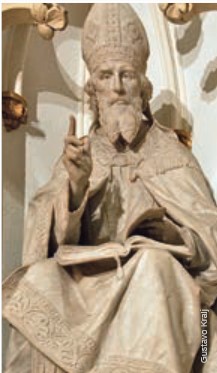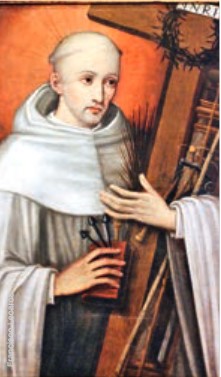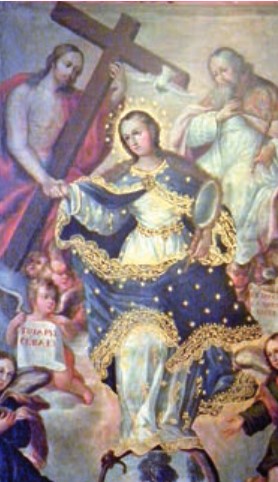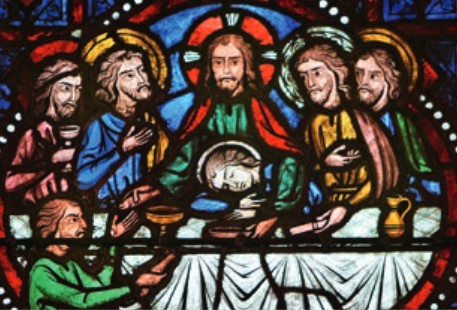This article continues on the exposition of the origin of Theology which came as a fruit from the desire to grow in the love of God and the desire for heavenly things in souls.
To read the first part, click here.
St. Anselm of Canterbury
Born of a noble family in Val d’Aosta, Italy, in 1033, Anselm entered the Cluniac abbey of Bec, in Normandy, where he led a life of strict monastic observance. “A monk with an intense spiritual life, an excellent teacher of the young, a theologian with an extraordinary capacity for speculation, a wise man of governance and an intransigent defender of libertas Ecclesiæ, of the Church’s freedom, Anselm is one of the eminent figures of the Middle Ages.”7 After Bec, we find him as Archbishop of Canterbury, England. He was one of the great prescholastics, and some even consider him the father of Scholasticism.

From him comes the famous maxim “fides quærens intellectum— faith seeking understanding,” of Augustinian origin. It is a formula in which we perceive this consortium between faith and reason, beautifully described in the first chapter of his Proslogion.8
St. Anselm manifests a highly speculative tendency, which distinguishes him from Benedictine spirituality. In his works, it is difficult to separate speculative from mystical theology. Benedict XVI warmly praises this outstanding medieval, “to whom Christian tradition has given the title: ‘Magnificent Doctor’, because he fostered an intense desire to deepen his knowledge of the divine Mysteries […]. The clarity and logical rigor of his thought always aimed at ‘raising the mind to contemplation of God.’ He states clearly that whoever intends to study theology cannot rely on his intelligence alone, but must cultivate at the same time a profound experience of faith.”9
Naturally, this great “theologian on bent knee” fostered an ardent love for the Virgin Mother of God. He did not write a single treatise on her, but his works contain passages so profound and filled with love that they have strongly influenced Mariological studies. Numerous authors point to St. Anselm as the defender of the Immaculate Conception, based on these words from his book De conceptu virginali et originali peccato: “It was fitting that the Blessed Virgin should shine with such purity that, under God, none greater can be conceived.”10
Evidently, this phrase does not declare the Immaculate Conception of Mary as defined by the Church centuries later, but speaks of a privilege granted to no other mortal. Furthermore, these words include precisely one of the strongest theological reasons that authors habitually present to prove the Immaculate Conception of Mary, which is her relationship with the three Persons of the Blessed Trinity, for the Only begotten of the Father, equal to Him, was Son of the Virgin, and at the same time had chosen her for Mother. The Holy Spirit had chosen her as Spouse, of whom He would engender the One from whom He Himself had proceeded.11 Although he did not explicitly affirm the Immaculate Conception, he prepared the way for subsequent theologians to reach this conclusion.
This great Saint, who gave up his soul to God on April 21 of 1109, “marked the eleventh century by his knowledge, his piety, and his battles, and led the Catholic Cause to victory. […] In considering his life, one has the impression of a formidable fortress, of a man who stood out in his time, who triumphed, and whose glory endures forever because of the victories that he obtained for the Faith.”12
St. Bernard of Clairvaux
There are other great Saints and outstanding theologians, true pillars of Christian doctrine, upon which the theological edifice rested during the medieval period. One of them shone like a sun, both for the holiness of his life and the clarity and profundity of his doctrine: St. Bernard of Clairvaux, “called ‘the last of the Fathers’ of the Church because once again in the twelfth century he renewed and brought to the fore the important theology of the Fathers.”13

Bernard was born in Burgundy, France, the third of seven sons of a noble family. He received a thorough education from the monks of ChâtillonsurSeine and demonstrated his prodigious vocation from his youth.
In 1112, before reaching 23 years of age, he arrived at the Monastery of Citeaux, leading a group of about 30 other nobles, all in search of the same ideal.14
“What do you seek?”—the abbot, St. Stephen Harding, asked them.
Falling to his knees, Bernard replied on behalf of all, using the ritual formula:“God’s mercy and yours.”
A monk who influenced the Church and society
Thus began the monastic life of this great Saint who, clothed in the Cistercian habit, would profoundly influence the Church and Christendom in his century and in those that followed.
Shortly after his entrance at Citeaux, St. Stephen Harding entrusted to him the mission of founding the Abbey of Clairvaux, which he governed until the end of his life. In short order, kings, princes, bishops, and even the Pope would consult him, marvelling at his wisdom.
He attended the Council of Troyes in 1129, and in 1130 was called to the Council of Étampes, where, thanks to his intervention, King Louis VI of France recognized the legitimacy of Pope Innocent II, whose election to the Papal Chair had been contested by an antipope. In 1145, his disciple and friend Bernard Pignatelli, abbot of a Cistercian monastery in Rome, was elected Pope with the name of Eugene III. St. Bernard wrote a treatise, De Consideratione, for this spiritual son raised to the Supreme Pontificate. In this work, the holy doctor “not only suggested how to be a good Pope, but also expressed a profound vision of the Mystery of the Church and of the Mystery of Christ, which is ultimately resolved in contemplation of the mystery of the Triune God.”15
Ardent lover of Jesus and Mary

Analyzing the doctrinal work of St. Bernard from a theological perspective, Benedict XVI highlights two main aspects: “They concern Jesus Christ and Mary Most Holy, His Mother. His concern for the Christian’s intimate and vital participation in God’s love in Jesus Christ brings no new guidelines to the scientific status of theology. However, in a more decisive manner than ever, the Abbot of Clairvaux embodies the theologian, the contemplative, and the mystic. […] the Holy Abbot described with passionate words Mary’s intimate participation in the redeeming Sacrifice of her Son. […] ‘So deeply has the violence of pain pierced your soul, that we may rightly call you more than a martyr, for in you, participation in the Passion of the Son by far surpasses in intensity the physical sufferings of martyrdom.’ Bernard had no doubts: ‘per Mariam ad Iesum’, through Mary we are led to Jesus. […] These reflections, characteristic of a person in love with Jesus and Mary as was Bernard, are still a salutary stimulus not only to theologians but to all believers.”16
Prolific writer
Amidst a life filled with great undertakings, the holy abbot of Clairvaux still found time to write his admirable works, whose doctrines and spirit are the portrait of his character and his time.
His sermons, on a wide range of subjects, numbered 340. Notable among these are those that treat of the Blessed Virgin Mary, some adorned with poetic prose and brilliant images.
St. Bernard also marked history through his important contribution to the development of some Christian devotions. He had a decisive role in spreading adoration to the most holy humanity of Christ, especially in the mysteries of Jesus’ infancy. Although he did not touch on the doctrine of the Immaculate Conception, he exalted the eminent sanctity of Mary and furthered the theme of her universal mediation. To him are attributed important prayers that propagate the doctrine of this mediation, such as the Memorare and the famous antiphon Salve Regina (Hail Holy Queen). He had the undeniable merit of directing hearts toward St. Joseph; until that time, the faithful guardian of the virginity of Mary had not been the object of special cult. He also contributed to spreading devotion to the Guardian Angels. However, this outstanding abbot’s greatest work of mystical theology is the Commentary on the Song of Songs, composed of 86 sermons, in which he clearly expresses his ideas on the mystical states and the degrees of prayer.17
One of the supreme guides of Christianity
St. Bernard fell asleep in the Lord on August 20 of 1153, at 63 years of age. It is said that the Mother of God appeared at his deathbed at the moment of his expiry, to receive his blessed soul. Before burying him, the monks of Clairvaux undertook the praiseworthy task of casting his effigy, the matrix of several images in which the holy abbot appears “with hollow cheeks, marked by deep creases, but whose broad forehead reveals intelligence and whose countenance radiates marvelous purity.”18

Nine centuries later, a modern historian summarized the role of the founder of Clairvaux with these words: “For the history of the Church of Christ, he continues to be the most perfect image of man that the Middle Ages could conceive, one of the supreme guides of Christianity on his path of light, a witness of his time before God.”19
Pope Pius VIII proclaimed him Doctor of the Church in 1830. And the theologian Pope Benedict XVI emphasized the importance of his vast doctrinal work for theological studies of all ages: “Some claim to have solved the fundamental questions on God, on man and on the world with the power of reason alone. St. Bernard, on the other hand, solidly founded on the Bible and on the Fathers of the Church, reminds us that without a profound faith in God, nourished by prayer and contemplation, by an intimate relationship with the Lord, our reflections on the divine mysteries risk becoming an empty intellectual exercise and losing their credibility. Theology refers us back to the ‘knowledge of the Saints’, to their intuition of the mysteries of the living God and to their wisdom, a gift of the Holy Spirit, which become a reference point for theological thought. Together with Bernard of Clairvaux, we too must recognize that man seeks God better and finds him more easily ‘in prayer than in discussion’. In the end, the truest figure of a theologian and of every evangelizer remains the Apostle John, who laid his head on the Teacher’s breast.”20
Excerpt from the Heralds of the Gospel magazine, #95.
Notes
7 BENEDICT XVI. St. Anselm of Aosta. General Audience, 23/9/2009.
8 Cf. ST. ANSELM OF CANTERBURY. Proslogion, c.1: ML 158, 225227.
9 BENEDICT XVI, St. Anselm of Aosta, op. cit.
10 ST. ANSELM OF CANTERBURY. De conceptu virginali et originali peccato, c.18: ML 158, 451.
11 Cf. Idem, ibidem.
12 CORRÊA DE OLIVEIRA, Plinio. Santo Anselmo, varão de muitas lutas [St. Anselm, man of many battles]. In: Dr. Plinio. São Paulo. Year XVIII. N.205 (Abr., 2015); p.29.
13 BENEDICT XVI. St. Bernard of Clairvaux. General Audience, 21/10/2009.
14 Cf. DANIELROPS, Henri. A Igreja das Catedrais e das Cruzadas. São Paulo: Quadrante, 1993, p.98.
15 BENEDICT XVI, St. Bernard of Clairvaux, op. cit.
16 Idem, ibidem.
17 Cf. ILLANES; SARANYANA, op. cit., p.35.
18 DANIELROPS, op. cit., p.133.
19 Idem, p.135.
20 BENEDICT XVI, St. Bernard of Clairvaux, op. cit.
